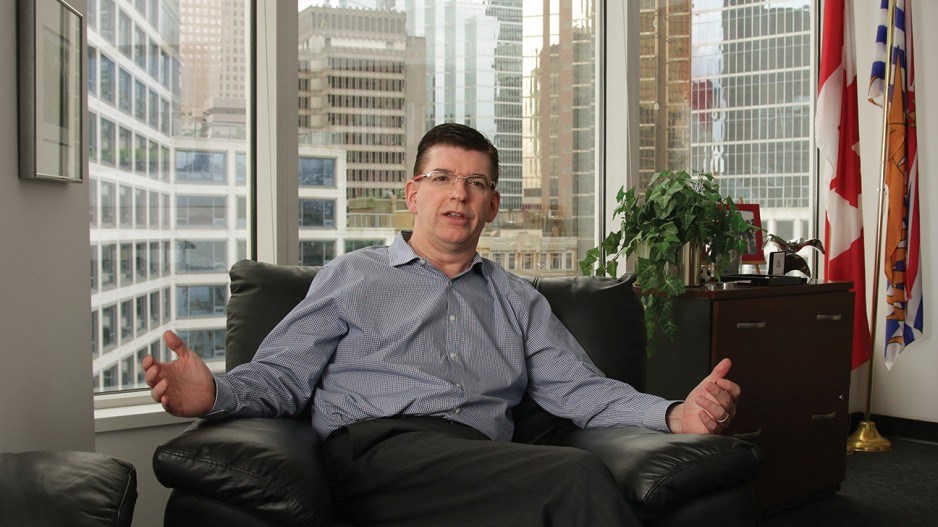It’s tough to fault first-term Surrey Mayor Linda Hepner for having a one-track mind when it comes to the upcoming provincial election.
Hepner’s predecessor, Dianne Watts, who hand-picked the former city councillor to take over after deciding not to run for a fourth term, noted in one of her final speeches as mayor in 2014 that she wished the city were closer to having light-rail transit (LRT).
Now, more than two years into Hepner’s first term, the city’s LRT project continues to inch forward. With an estimated $2.1 billion price tag that includes two lines, 19 stops and 27 kilometres of rail stretching south to Newton and southeast to the city of Langley, the project’s remaining funding is still a huge question mark.
“I understand Dianne’s frustration because I’ve spent two years now in my office pushing for exactly the same thing,” Hepner said. “And hoping that I would be farther down the line than we are right now, so procurement readiness is top of my wish list.”
Hepner said she’s waiting for federal budget funding details for transportation infrastructure projects across the country – which should, in turn, coax a financial commitment from the winning side in B.C.’s May 9 provincial election.
Last November, the Mayors’ Council on Regional Transportation and TransLink’s board approved Phase 1 of the transportation authority’s 10-year plan for regional transit, which includes pre-construction and consultation for Surrey’s LRT. The city received design funding from TransLink in November 2015. However, it appears everything is now in stasis again as the provincial election kicks into high gear.
Last June, the federal government announced its intention to raise its stake in transportation infrastructure, from its traditional one-third funding contribution to one-half of the bill for proposed projects across Canada. The funding announcement included $616 million to the Mayors’ Council, of which $99 million was earmarked towards pre-construction planning and consultation for the proposed Broadway subway in Vancouver, and $58 million for planning of Surrey LRT.
Hepner said she needs traction on the project now as her city continues to lead growth in the region and is expected to take in an additional 300,000 people over the next three decades.
“I don’t think that we can absorb the number of people that we expect outlined in the regional growth strategy in the area south of the Fraser [River] and not have a very strong rapid transit option available.”
Hepner is not alone in her frustration with Surrey’s LRT project. Last fall, the Greater Vancouver Board of Trade (GVBOT) asked its 5,000 members what their top priorities were for the 2017 provincial election. Transit and transportation was No. 1. Members singled out LRT as the most important project, giving it priority over the Broadway Millennium Line expansion and the $3.5 billion George Massey Tunnel replacement, a 10-lane bridge expected to start construction in 2017 and be completed by 2022. That project is being championed by the provincial government but is opposed by the Mayors’ Council for reasons that include cost, construction impact and feasibility.
GVBOT president and CEO Iain Black acknowledged government needs to do more – outside of general taxes and levies – to fund major transportation projects across the Lower Mainland. In its recent provincial election survey, 68% of GVBOT members are in favour of either road tolling or distance pricing for commuters.
However, Black said, it’s important that people keep a sense of perspective when it comes to the region’s overall standing.
Black said that despite the SkyTrain being 30 years old, its rate of malfunctions is low compared with other major cities’ public transportation infrastructure. In January, Moody’s Investors Service gave TransLink an “Aa2 stable” rating, the company’s third best.
TransLink’s ridership numbers hit an all-time high last year, reaching 384.83 million boardings in 2016, a 4.5% increase from 362.92 million in 2015, which itself was also a record-breaking year. Increases were seen across the board from SkyTrain and SeaBus to the West Coast Express and bus services. TransLink also set up an accountability centre to track performance and customer satisfaction.
“Do we have a good transit system here relative to the investment that has been made? Yes,” Black said. “The operating measurements for TransLink for bus and rail are among the best in the world. So I do agree that there are two narratives when it comes to transit.”
Black said the transit plebiscite in 2015 that would have raised $7.5 billion for transit expansion through a sales tax failed because it was rushed, provoking a knee-jerk reaction against increased taxes in general. However, he said, it started a discussion about how the cities and region will fund transit improvements on a larger scale.
Robin Lindsey, a professor at the University of British Columbia’s Sauder School of Business who has studied public transportation extensively, said there’s pretty much only one thing you can count on with any transportation infrastructure project.
“We know from evidence around the world, going back 70 or more years, that these projects often encounter cost overruns and delays. So that is the one thing that needs to be taken into account all of the time.”




